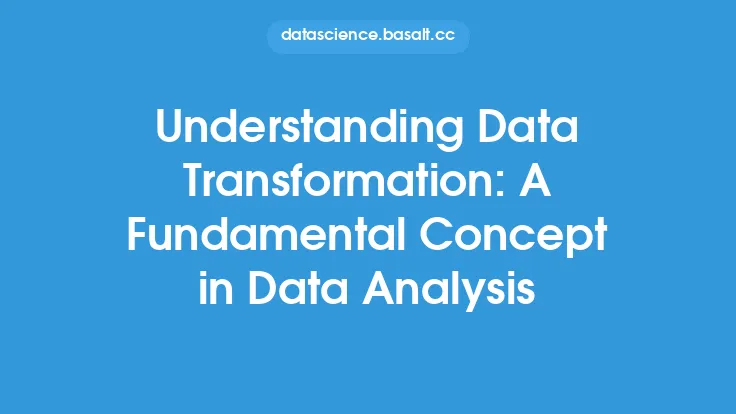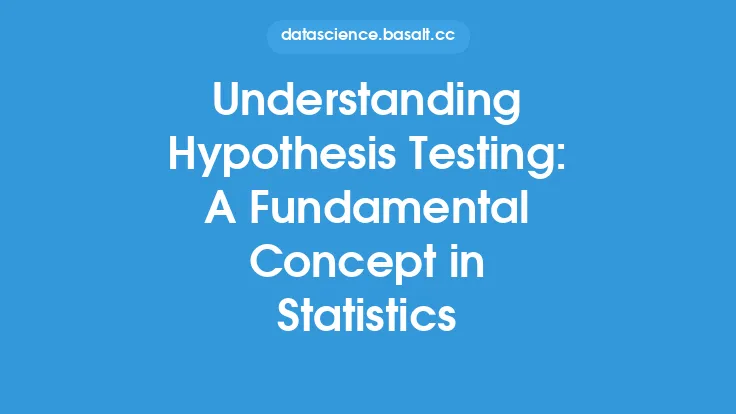Data transformation is a critical process in data mining that involves converting raw data into a suitable format for analysis. This process is essential because raw data is often collected from various sources, and it may be in a format that is not suitable for analysis. The goal of data transformation is to transform the raw data into a format that is consistent, reliable, and useful for analysis. In this article, we will delve into the fundamentals of data transformation, its importance, and the various techniques used to transform data.
Introduction to Data Transformation
Data transformation is a fundamental concept in data mining that involves a series of processes that convert raw data into a format that is suitable for analysis. The process of data transformation involves several steps, including data cleaning, data integration, data transformation, and data reduction. Data cleaning involves removing errors and inconsistencies from the data, while data integration involves combining data from multiple sources into a single dataset. Data transformation involves converting the data into a suitable format for analysis, and data reduction involves reducing the size of the dataset to make it more manageable.
Types of Data Transformation
There are several types of data transformation, including aggregation, normalization, feature scaling, and feature extraction. Aggregation involves combining multiple values into a single value, such as calculating the mean or sum of a set of values. Normalization involves scaling the data to a common range, usually between 0 and 1, to prevent differences in scales from affecting the analysis. Feature scaling involves scaling the data to a common range, usually between 0 and 1, to prevent differences in scales from affecting the analysis. Feature extraction involves extracting relevant features from the data, such as extracting keywords from a text document.
Data Transformation Techniques
There are several data transformation techniques, including logarithmic transformation, square root transformation, and standardization. Logarithmic transformation involves transforming the data using the logarithm function, which is useful for reducing the effect of extreme values. Square root transformation involves transforming the data using the square root function, which is useful for reducing the effect of extreme values. Standardization involves transforming the data to have a mean of 0 and a standard deviation of 1, which is useful for preventing differences in scales from affecting the analysis.
Importance of Data Transformation
Data transformation is essential in data mining because it enables the analysis of large datasets. Raw data is often collected from various sources, and it may be in a format that is not suitable for analysis. Data transformation converts the raw data into a format that is consistent, reliable, and useful for analysis. Without data transformation, it would be difficult to analyze large datasets, and the results of the analysis may be inaccurate or misleading.
Data Transformation Tools and Software
There are several data transformation tools and software available, including Excel, SQL, and programming languages such as Python and R. Excel is a popular spreadsheet software that provides a range of data transformation tools, including data cleaning, data integration, and data transformation. SQL is a programming language that is used to manage and analyze relational databases, and it provides a range of data transformation tools, including data cleaning, data integration, and data transformation. Python and R are popular programming languages that provide a range of data transformation tools, including data cleaning, data integration, and data transformation.
Challenges and Limitations of Data Transformation
Data transformation is a complex process that involves several challenges and limitations. One of the main challenges of data transformation is data quality, which refers to the accuracy, completeness, and consistency of the data. Poor data quality can affect the results of the analysis, and it may be difficult to transform the data into a suitable format for analysis. Another challenge of data transformation is data complexity, which refers to the complexity of the data, including the number of variables, the relationships between the variables, and the format of the data. Data complexity can make it difficult to transform the data into a suitable format for analysis.
Best Practices for Data Transformation
There are several best practices for data transformation, including data quality checking, data documentation, and data validation. Data quality checking involves checking the data for errors and inconsistencies, and it is essential to ensure that the data is accurate, complete, and consistent. Data documentation involves documenting the data, including the source of the data, the format of the data, and the transformations that were applied to the data. Data validation involves validating the data, including checking the data for errors and inconsistencies, and it is essential to ensure that the data is accurate, complete, and consistent.
Conclusion
In conclusion, data transformation is a critical process in data mining that involves converting raw data into a suitable format for analysis. The process of data transformation involves several steps, including data cleaning, data integration, data transformation, and data reduction. There are several types of data transformation, including aggregation, normalization, feature scaling, and feature extraction. Data transformation is essential in data mining because it enables the analysis of large datasets, and it is a fundamental concept in data mining. By following best practices for data transformation, including data quality checking, data documentation, and data validation, data miners can ensure that the data is accurate, complete, and consistent, and that the results of the analysis are reliable and useful.





